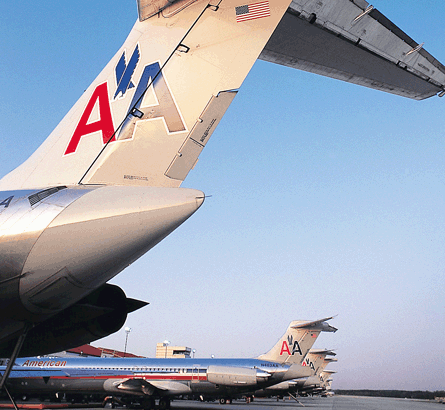Difficult operating conditions are impacting asset values and no relief appears to be on the horizon for at least the next 12 months as airlines continue to cut capacity to match falling travel demand. There are currently about 2,350 commercially operated narrowbody and widebody jets parked, which is some 500 more than at this time last year. That number could reach 3,000 by year-end, say analysts. According to Flight's ACAS database, there are 1,870 narrowbodies parked, or 14% of the total narrowbody fleet, while parked widebodies account for 10% of the total fleet.
Transactions are happening but not at the levels experienced a year ago. Jeffrey Knittel, president of transportation finance at CIT, summarises the situation: "On a current basis some operators are still willing to take aircraft but the issue is in one or two years ahead when airlines are not making any decisions."
Adds Stephen Hannahs, chief executive of Aviation Capital Group: "We have seen a global deterioration in certain parts of the world in the final quarter of 2008." According to Hannahs, older Boeing 737 Classics have seen lease rates drop by 50% over the past 15 months. "Demand is softer in general commercial terms," he says.
AWAS says all aircraft types have lost value and lease rates. According to AWAS' analysis, small narrowbodies are the most heavily impacted. AWAS chief executive Frank Pray says a 20-25% drop in lease rates has been the norm. Medium narrowbody and medium widebody aircraft lease rates have been 10-15% down, with the smaller percentage applying to newer aircraft.
The spread between used and new aircraft is more noticeable on larger widebodies. Pray says lease rates have dropped by 15% for new aircraft and by 30% for used aircraft. "I don't see lease rates further declining for newer aircraft but I see more potential volatility for older aircraft," he adds.
 |
|---|
© American Airlines |
Orix Aviation senior vice-president marketing John Leech says lease rates have dropped by 25-30% on Boeing 737 Classics over the past three months. "Since the end of the fourth quarter 2008, lease rates on new generation aircraft have dropped by 10% to 15%. Lease rates have softened and this year we will see a continuation of this trend because there is an oversupply of aircraft in the marketplace. This results from airlines reducing capacity as traffic is down as well as a number of airlines ceasing operations and consequently returning aircraft to lessors," he says, adding that 35-40% of the 737-300 fleet is currently being traded in the market.
Appraiser companies are more conservative. Avitas vice-president asset aviation Doug Kelly says lease rates fell in the last quarter of 2008 by 10% on average for newer, in-production aircraft and 20% for older aircraft. Adds MBA chief executive Bob Agnew: "Lease rates moved down for almost all categories of aircraft. The more popular and fuel-efficient aircraft appeared to be softening in the 5-15% range. Less popular aircraft appeared to be softening in the range of 10-20%."
IBA Group senior analyst Jonathan McDonald expects further slippage. "Some short-term diminution on the otherwise very liquid 737-700, thanks to operator failures at Aloha and Sterling, but in all honesty lease rates across all types will gradually slip over the next year. Over a wider time frame between 12% and 16% diminution is not unrealistic even for the more popular types," he says.
"Lease rates are down maybe 10-25%, but this has to be viewed in conjunction with the prevailing interest rates," argues Ascend director of consultancy Eddie Pieniazek. "A low interest rate has played its part." Hannahs agrees: "While lease rates have dropped, the cost of borrowing is significantly down. In ACG's case, borrowing costs are 18% down across the portfolio so even with lower rentals, we are still profitable."
"We are starting to get to a point where we see a double-digit drop in lease rates but it is also coupled with interest rate drops. So this helps to protect profitability of the transaction," adds Knittel.
Hannahs says Airbus A320 or Boeing 737-800 models trading in excess of $400,000 a month 15 months ago are now in the $340,000 to $360,000 monthly lease range. Compared with other models, these two popular aircraft are holding up well.
 |
|---|
"I don't see lease rates declining for new aircraft but i see more volatility for older aircraft"Frank Pray - Chief executive, AWAS |
The 737-700 model has seen lease rates more impacted over the past six months. At the beginning of last year, lease rates ranged from $240,000 to $390,000 a month. Since then Aloha's passenger business and Sterling Airlines have ceased operations, releasing 23 aircraft into the marketplace. Over the last six months AirTran Airways has continued to sell some aircraft, easyJet has started retiring its 737-700 fleet while GECAS has repossessed six aircraft from SkyEurope. Offerings are believed to have dropped to the $215,000 to $230,000 bracket for old models, while some offers in Europe have been made below $200,000 a month. Hannahs says the 737-700 models are more commonly trading in the $235,000 range for newer variants.
While the Boeing Next Generation aircraft have held up, the Classic fleet, especially the -300 and -400 models, have experienced significant falls. Older models attract lease rates well below the $100,000 mark in the US, where overcapacity is the problem. Some Boeing 737-400 aircraft have beenoffered at around $140,000 a month compared with $180,000 a month a year ago, while a recent transaction on a Boeing 737-300 fetched $125,000 a month.
Even sharper falls have been observed on older narrowbody aircraft, especially those built in the mid-1980s. Hannahs says the mid-80s Classics have seen rental down by 50% over the past year while the mid-1990s Classics are trading at 25-30% lower lease rates.Collateral Verifications believes the Boeing 737 Classics will be one of the types that will be most impacted by the downturn in 2009. "We have already seen lease rates and values drop by more than 30% and we expect values to continue to drop in 2009," says vice-president commercial aviation services Gueric Dechavanne. "Based on historical trends, our opinion is that these aircraft could further drop by an additional 20-30% in the next 12 months. The availability of these aircraft continues to increase and although many of these will find new homes with second- and third-tier carriers, it has become a buyer's market with operators and investors having the ability to choose the cream of the crop at very attractive prices and lease rates."
Dechavanne believes the logical trend would be for some of these aircraft to be converted to freighters. "However, as the cargo operators continue to struggle this option has now been pushed back a few years, hurting the values of these aircraft further."
The Boeing MD-80 fleets could experience a similar fate as the DC-9 a few years ago. Dechavanne even believes the MD-80 fleets have no real future. "The MD-80 values and lease rates have been continually coming down and with American Airlines slowly getting rid of their massive fleet, I don't see any real future for the aircraft whatsoever," he says. "At this point, parting out the aircraft is an obvious choice but the longer operators and investors wait to do so, the more saturated this market will become driving prices for the parts downward."
Older Airbus A320 aircraft are also suffering from downward valuations. In one case an early A320-200 model received offers at $130,000 a month while the lessor anticipated a rental in the $170,000 a month region. There is a fairly dramatic difference now between trading young and old models. Knittel outlines two reasons: "Airlines operating old aircraft are taking the opportunity to step up with newer aircraft and also newer aircraft operators are taking the opportunity to refresh their fleet," he says. At the lower end of the market, some A320s have traded at $5.6 million recently while offers have dropped to $5 million for 15-year old aircraft.
The new A320 models are not immune. AerCap chief executive Klaus Heinemann says: "On an A320-200 on a recent purchase offer that we received, which by the way is above our own purchase cost by some significant amount, I see a reduction from a level of around about $43 million to $44 million, which is where it would have been at the peak, to $41 million."
The big question is whether the market could recover later this year. Agnew says: "With significant contraction by major carriers and manufacturers continuing to produce aircraft close to record levels, a glut in the market will likely stay with us throughout 2009." Pieniazek anticipates an increase in used jet transactions this year, though not an improvement in values. "We see continued pressure keeping market values below base values for at least 18 months. There is no immediate reason to assume otherwise."
Source: Airline Business























